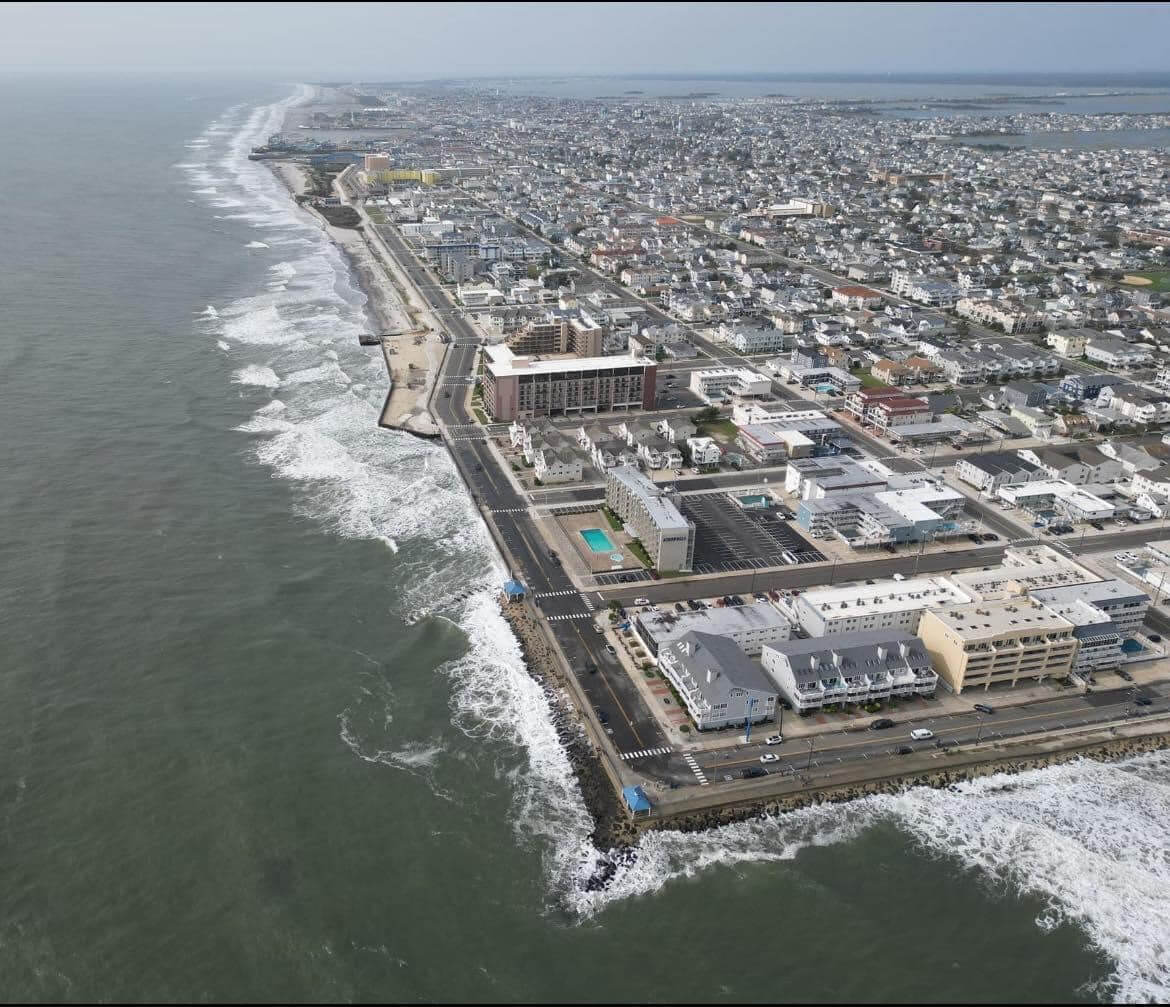DEP Points Finger at Towns, But Appears to Have Done Little to Advance It
It’s been a decade since a project to construct a dune designed to protect the Wildwoods from the ocean was first presented to the public. But no dune has been built, and the ocean has since decimated the beaches of North Wildwood.
Meanwhile, the state agency responsible for obtaining real estate agreements, called easements, which are necessary to begin construction, appears to have made few of the more than 100 prerequisite acquisitions.
The long-delayed project for the dune, spanning the Wildwoods’ oceanfront, cannot be built until the New Jersey Department of Environmental Protection gets the easements from public and private beach owners.
An easement provides its owner with the right to use land for a specific purpose without actually owning it. In this case, they are mostly needed to allow the dune to cross the parts of the beach owned by private parties and municipalities.
Some of the easements would allow for sand to be removed from parts of the beach in Wildwood and Wildwood Crest, near the shoreline. The removed sand would be used to create the dune in all four municipalities and an elevated beach in front of the dune in North Wildwood.
The DEP, the agency solely responsible for acquiring the real estate permissions, made a feasibility cost-share agreement with its construction partner, the U.S. Army Corps of Engineers, in 2013. Some 65% of the initial construction cost will be paid by the feds, with the state paying 75% of the remaining 35%, leaving the rest to the municipalities. The project was presented to the public in 2014.
Since 2017, the DEP “has begun to acquire the necessary real estate to construct the project,” a description on the Army Corps’ website states. However, seven years later, construction is still being delayed by the incomplete real estate easement acquisitions.

Where Is the DEP in the Easement Acquisition Process?
In response to an inquiry from the Herald in January, a DEP spokesman said, “The DEP is currently working through the title search and survey phase of the easement acquisition process and does not have a final number of how many easements are needed for each of the municipalities.”
Although the DEP was not forthcoming in response to this newspaper’s inquiry – which sought specific information on which properties the agency still needs easements for – the properties are already identified as part of exhibits in separate state aid agreements signed by the DEP, which the agency entered with North Wildwood and Wildwood Crest in March 2022, and with Wildwood and Lower Township in February 2023. Lower Township includes Diamond Beach, which is why it is one of the four municipal partners.

An Army Corps spokesman said it would likely be a matter of months before the Corps is ready to begin construction of the dune and berm, once its partner, the DEP, acquires the needed real estate easements. When the DEP has them, designs can be finalized and the project – which would relocate more than 1.3 million cubic yards of sand – can go out to bid, the Army Corps spokesman, Steve Rochette, told the Herald.
According to the Herald’s research, which relied on public records requests in the absence of transparency from the state agency, there are about 130 easements required. The exact number is slightly obscure because of the way the properties are listed in the publicly available contracts between the state and the four involved municipalities, which use block and lot numbers. Sometimes multiple block and lot numbers are controlled by one party.
Who Owns the Properties the DEP Needs Easements For?

There are four parties who own a large percentage of the property involved. Morey’s Piers owns 12 lots that will require easements, 11 of which are in Wildwood. Wildwood Crest owns 43 lots requiring easements, and the City of Wildwood owns 11. North Wildwood has granted easements for the eight properties it needed to sign off on.
In total, there are about 35 different parties the DEP needs to strike agreements with, and according to the Herald’s research, only two of them have signed off at this point. While the DEP spokesman told the Herald the total number of easements “will be fluid as work advances,” it appears little progress has been made in three of the four municipalities.
In North Wildwood, where circumstances are the direst, the DEP has acquired nine of 10 easements, according to the state Attorney General’s Office. Eight of the 10 are from the city, and one is from Sportland Pier, leaving Morey’s Surfside Pier, at 26th Avenue and the boardwalk, the only easement the DEP still needs in North Wildwood.
Will Morey, the chief executive of Morey’s Piers, said in an interview with the Herald that he has communicated with the DEP and believes the agency is sincere in its efforts to accomplish the project. He said Morey’s Piers has been involved in talks with the DEP since the project’s inception, but that his company, perhaps the county’s most prominent business, is now waiting on the DEP to further the discussions.
“They’ve had to go through the process of gaining municipality sign-on, etc.,” Morey said. “So, ultimately, the individual property acquisition stuff is something that, I think, they’re just ready to start with again. We’ve been kind of waiting on that process, quite frankly.”

Morey and his brother, Jack, are second-generation owners of Morey’s Piers, which operates three active oceanfront amusement piers, including two waterparks, all accessed from the boardwalk – Mariner’s Pier and Adventure Pier, in Wildwood, and Surfside Pier, in North Wildwood.
North Wildwood Mayor Patrick Rosenello has been highly critical of the DEP, and his city is suing the state agency, charging a lack of action on shore protection. In a development first reported by the Herald, shortly after the city sued the DEP for $21 million for allegedly breaching contracts related to shore protection responsibilities, the DEP fined the city $12.8 million, with many of the underlying violations stemming from unauthorized city projects to fortify the oceanfront, including installing about 10 blocks of bulkhead.
Rosenello said he was very confident the Moreys would not cause any delay to the dune project he has desperately been waiting for.
“I have no doubt in my mind that the Moreys would quickly supply that easement to get this project moving, facing some serious issues at the end of their pier as well,” the mayor told the Herald.
Morey’s Surfside Pier, protected by a rusting, damaged metal bulkhead that is often battered by waves during extreme high tides and storms, is on the city’s southern border with Wildwood. That location is North Wildwood’s least vulnerable area, but even there, concerns are increasing as erosion worsens.

Morey said the dune project, which will run closer to the boardwalk, likely won’t add protection in front of the piers. The issues his company is working through with the state include creating shore protection while allowing egress for construction equipment and other things necessary to pier operations.
“It may even be something that can be sort of mobile and put in and out of place. There have been a few ideas around that that have been discussed,” Morey said.
“We’ve been advocates of the project and expect to be able to work through these property arrangements without any significant issue.”
In Wildwood Crest, there are no private easements required, but a total of 43 public easements are needed, according to the state aid agreement. Wildwood Crest Mayor Don Cabrera said the borough has not yet started authorizing the required easements.

“There are some issues that still must be resolved on the island and thus the delay on moving forward,” Cabrera told the Herald. “Wildwood Crest is still working through a few issues involving the [Heather Road] pier, ADA crossovers, LERRD credit details and a few other matters.”
LERRD, an acronym for Lands, Easements, Rights of Ways, Relocations and Disposals, is a reference to credits offered when they are determined to be required for a federal project. Generally, the value of the LERRDs is applied to the project cost share.
Cabrera said Wildwood Crest is “waiting on DEP to get back to us on our questions and overall plan.”
Within Wildwood, 71 easements are required, according to that city’s state aid agreement. In addition to the 11 Morey properties, the city owns 11 of the parcels in the area where the dune would be built that the DEP needs easements for.
Ernie Troiano Jr., who was reelected Wildwood’s mayor in November after spending four years on the sidelines, told the Herald he would review what has changed in the plan since he was last in office. When the plan for the dune was presented in 2014, he told the Philadelphia Inquirer he felt “the idea is ludicrous.”

Troiano told the Herald in January he is “trying to understand the changing of the dune location.”
Under former Mayor Pete Byron, the city inked its state aid agreement, but with Byron now out, Troiano isn’t clear on his current position, and it remains to be seen how much influence he might have at this stage if he remains opposed to the project.
In Lower Township’s Diamond Beach neighborhood, easements are needed for four different properties, all of which are private, according to the township’s state aid agreement.
The properties are The Grand, an upscale condominium building; the ICONA Resort, a hotel that includes a beach bar; Seapoint Village, another beachfront condo complex, and the Club at Diamond Beach, which offers a members-only bar and beach area.
Questions about how the dune might interfere with business operations that use private parts of the beach may prove to be a complicating factor when those easements are negotiated.
North Wildwood Is Tired of Waiting

Mayor Rosenello has little faith in the DEP and was disappointed when informed by the Herald that the agency is only now in the “title search and survey phase.”
“That response is just proof of the incompetence that the DEP has shown with regard to this project for a decade,” he said. “This project has been on the board for 11 years, and the fact that they don’t even know what easements they need is absolutely incredible to me.
“It’s very simple. … A competent title search person would probably have that list for them in a day, so I can’t explain it.”

In a letter sent from Shawn M. LaTourette, the DEP commissioner, to Rosenello in October 2023, the commissioner blamed the delays on a “municipal standoff,” writing: “The delay is solely a product of the years-long refusal of neighboring Five Mile Island municipalities to accept the project.”
“That neighboring community leaders would not previously support this free barrier islandwide resilience solution is incomprehensible.”
The DEP commissioner, the agency’s top official, was appointed to the position by Gov. Phil Murphy in 2021. He told Rosenello in the letter that the project is “anticipated to begin construction in early 2025.”
But Rosenello said he doesn’t get how the DEP can be saying that, given what little work he said they have done to obtain easements.
“I don’t understand how they can give us [that] time frame when they don’t even know what easements they need to get to construct a project,” he said.
LaTourette had agreed to an interview with the Herald in the fall but canceled at the last minute without explanation, declining to reschedule.


Contrary to his criticisms of the DEP, Rosenello said he does have faith that the Army Corps will be a reliable partner.
“The Army Corps of Engineers has been very professional, very responsive, very concerned,” he said. “The Army Corps has done everything in their power to move this project along. And unfortunately, there has been this roadblock at the DEP for a decade.”

What Are the Project Specifics and Is It Necessary in Wildwood, the Crest and Diamond Beach?
Despite the obvious need for a beach replenishment project in North Wildwood, some further south on the island have wondered about an island-wide project’s potential negative impacts.
Some worry about how the dune would disrupt beach access and block views, concerns they don’t feel are overshadowed by urgency for storm protection on those parts of the island, where wide beaches mostly keep the waves far from city streets and the boardwalk.
Others in those parts of the island have expressed concerns that harvesting sand to create the dune and consequently shortening the beach may not necessarily create better shore protection. One homeowner in Wildwood Crest invoked the proverbial saying “If it ain’t broke, don’t fix it.”

Rochette, the Army Corps spokesman, told the Herald the dune and elevated beach accompanying it work together to provide more effective shore protection than the wide but flat beach that currently exists on those parts of the island.
Rochette said the method of harvesting sand from within the island is not something the Army Corps has done in this district, and he was not aware of any projects utilizing this specific method undertaken by the Army Corps elsewhere in the country.
“To have a dune plus a substantial elevated beach berm in front of it is really the best option,” he said. “During a storm event, there’s significant wave energy, and the dune is kind of that last line of protection. In some cases, it can really reduce the risk of storm damage to infrastructure.”
During construction, the contractor hired will not borrow sand to build the dune and berm from an inlet or other offshore borrow area, as is typical with other Army Corps-designed projects in New Jersey, but will instead use sand that exists on the beaches of Wildwood and the Crest, harvesting it and hydraulically pumping it to create the dune and berm.

Beside the inconvenience factor of a long trek across the hot sand to get to the ocean on a summer day, the wide beaches also cause issues with flooding on the island after rains, because gravity outfalls that normally drain storm sewers into the ocean become clogged with sand. Pools of stagnant water are also ubiquitous on the wide beaches, posing health concerns the Army Corps is seeking to address with the project.
The Hereford Inlet to Cape May Inlet Hurricane and Storm Damage Reduction Project, as it’s officially called, would build a 25,000-foot-long dune with a crest at an elevation of 16 feet for the length of Five Mile Island, in reference to the North American Vertical Datum of 1988.
As a point of reference, the surface of the Wildwood Boardwalk varies from 14 to 14.5 feet NAVD88, an engineer for that city told the Herald. The top of the bulkheads in North Wildwood are at an elevation of about 12 feet NAVD88, an engineer for that city said. NAVD88 is a reference coordinate with a surface of zero elevation, which is currently a standard surveying reference in the U.S.
The crest of the dune would be 25 feet wide, and the project would add 64 acres of dune grasses to the island. The project would also construct the North Wildwood berm on the oceanside of the dune, raising the elevation to 6.5 feet NAVD88 for varying widths. Along the length of the project, there would be about 51 pedestrian crossovers and 13 vehicle and Americans with Disabilities Act compliant crossovers.
The Five Mile Dune Project will also include measures that could lead the height of the dune to grow, like fencing designed to retain wind-blown sand, a municipal engineer for North Wildwood said. Every four years, for 50 years after the project’s initial construction, renourishment is authorized, with the feds paying 50% of the renourishment costs and the other 50% being divided 75/25 between the state and municipalities respectively.
Contact the author, Shay Roddy, at sroddy@cmcherald.com or 609-886-8600, ext. 142.








